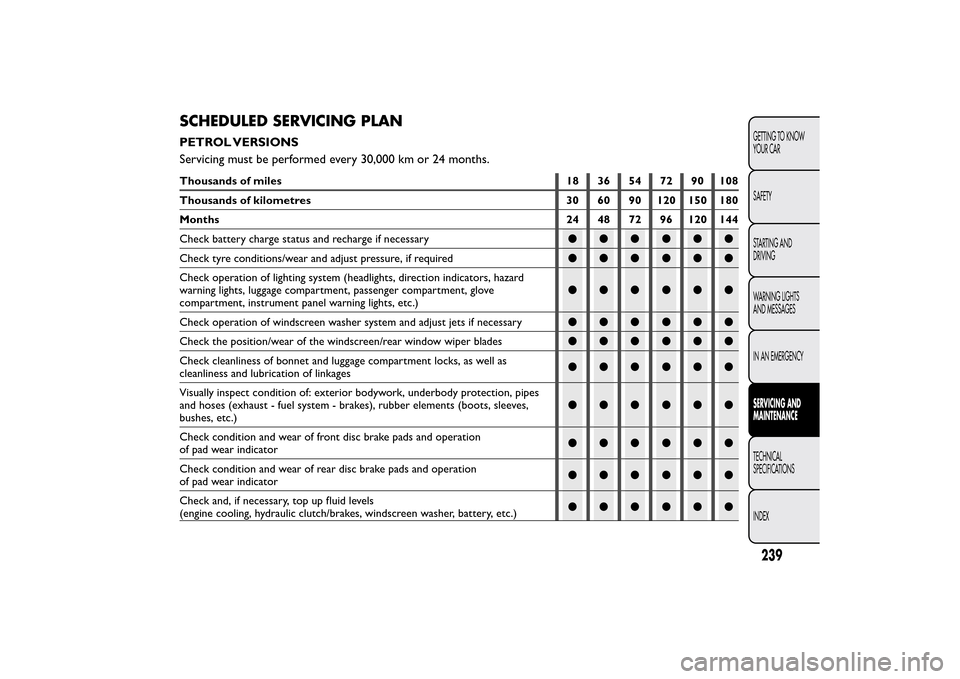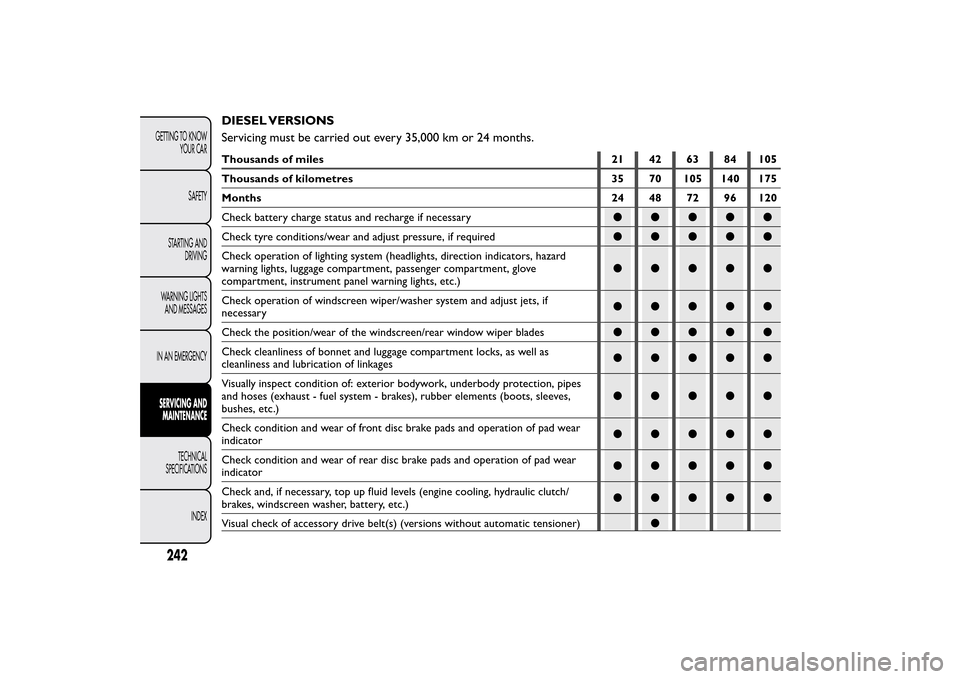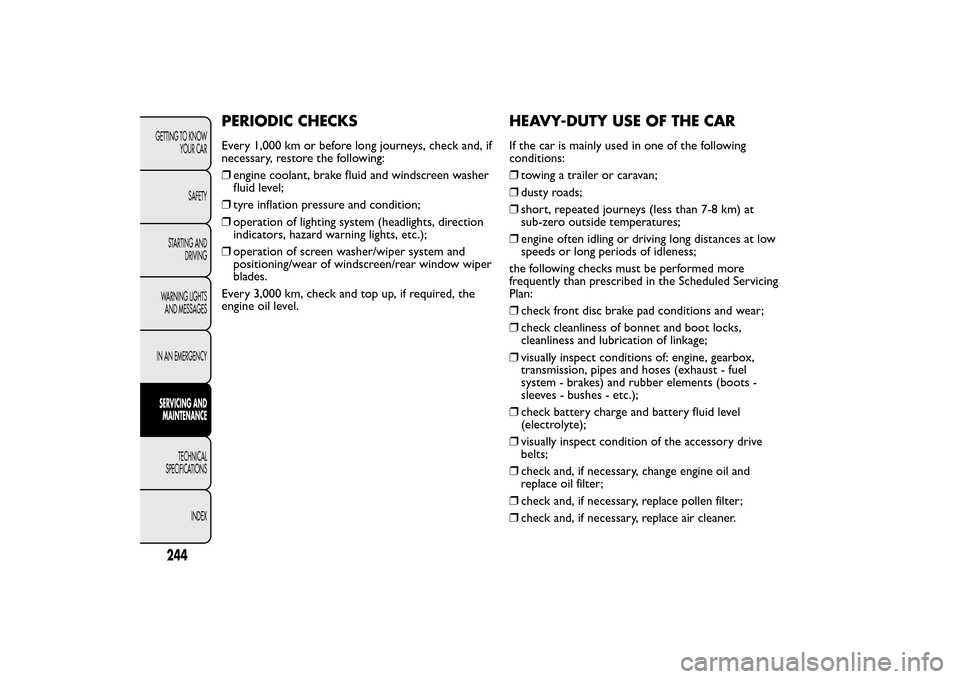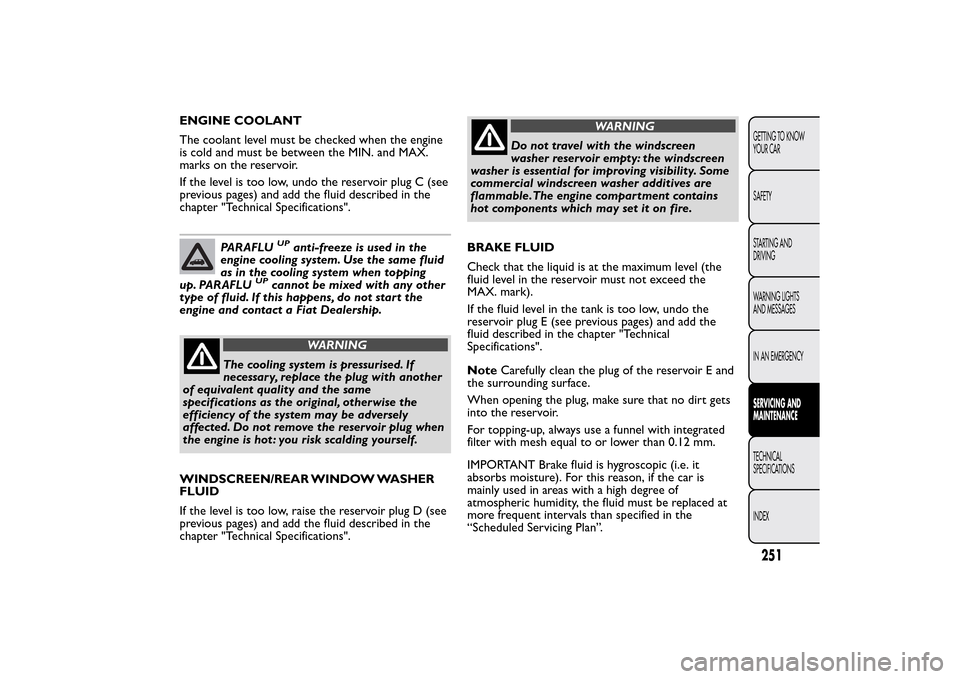Page 243 of 420

SCHEDULED SERVICING PLANPETROL VERSIONS
Servicing must be performed every 30,000 km or 24 months.Thousands of miles 18 36 54 72 90 108
Thousands of kilometres 30 60 90 120 150 180
Months 24 48 72 96 120 144
Check battery charge status and recharge if necessary●●●●●●
Check tyre conditions/wear and adjust pressure, if required●●●●●●
Check operation of lighting system (headlights, direction indicators, hazard
warning lights, luggage compartment, passenger compartment, glove
compartment, instrument panel warning lights, etc.)●●●●●●
Check operation of windscreen washer system and adjust jets if necessary●●●●●●
Check the position/wear of the windscreen/rear window wiper blades●●●●●●
Check cleanliness of bonnet and luggage compartment locks, as well as
cleanliness and lubrication of linkages●●●●●●
Visually inspect condition of: exterior bodywork, underbody protection, pipes
and hoses (exhaust - fuel system - brakes), rubber elements (boots, sleeves,
bushes, etc.)●●●●●●
Check condition and wear of front disc brake pads and operation
of pad wear indicator●●●●●●
Check condition and wear of rear disc brake pads and operation
of pad wear indicator●●●●●●
Check and, if necessary, top up fluid levels
(engine cooling, hydraulic clutch/brakes, windscreen washer, battery, etc.)●●●●●●
239GETTING TO KNOW
YOUR CAR
SAFETY
STARTING AND
DRIVING
WARNING LIGHTS
AND MESSAGES
IN AN EMERGENCYSERVICING AND
MAINTENANCETECHNICAL
SPECIFICATIONS
INDEX
Page 246 of 420

DIESEL VERSIONS
Servicing must be carried out every 35,000 km or 24 months.Thousands of miles 21 42 63 84 105
Thousands of kilometres 35 70 105 140 175
Months 24 48 72 96 120
Check battery charge status and recharge if necessary●●●●●
Check tyre conditions/wear and adjust pressure, if required●●●●●
Check operation of lighting system (headlights, direction indicators, hazard
warning lights, luggage compartment, passenger compartment, glove
compartment, instrument panel warning lights, etc.)●●●●●
Check operation of windscreen wiper/washer system and adjust jets, if
necessary●●●●●
Check the position/wear of the windscreen/rear window wiper blades●●●●●
Check cleanliness of bonnet and luggage compartment locks, as well as
cleanliness and lubrication of linkages●●●●●
Visually inspect condition of: exterior bodywork, underbody protection, pipes
and hoses (exhaust - fuel system - brakes), rubber elements (boots, sleeves,
bushes, etc.)●●●●●
Check condition and wear of front disc brake pads and operation of pad wear
indicator●●●●●
Check condition and wear of rear disc brake pads and operation of pad wear
indicator●●●●●
Check and, if necessary, top up fluid levels (engine cooling, hydraulic clutch/
brakes, windscreen washer, battery, etc.)●●●●●
Visual check of accessory drive belt(s) (versions without automatic tensioner)●
242GETTING TO KNOW
YOUR CAR
SAFETY
STARTING AND
DRIVING
WARNING LIGHTS
AND MESSAGES
IN AN EMERGENCYSERVICING AND
MAINTENANCE
TECHNICAL
SPECIFICATIONS
INDEX
Page 248 of 420

PERIODIC CHECKSEvery 1,000 km or before long journeys, check and, if
necessary, restore the following:
❒engine coolant, brake fluid and windscreen washer
fluid level;
❒tyre inflation pressure and condition;
❒operation of lighting system (headlights, direction
indicators, hazard warning lights, etc.);
❒operation of screen washer/wiper system and
positioning/wear of windscreen/rear window wiper
blades.
Every 3,000 km, check and top up, if required, the
engine oil level.
HEAVY-DUTY USE OF THE CARIf the car is mainly used in one of the following
conditions:
❒towing a trailer or caravan;
❒dusty roads;
❒short, repeated journeys (less than 7-8 km) at
sub-zero outside temperatures;
❒engine often idling or driving long distances at low
speeds or long periods of idleness;
the following checks must be performed more
frequently than prescribed in the Scheduled Servicing
Plan:
❒check front disc brake pad conditions and wear;
❒check cleanliness of bonnet and boot locks,
cleanliness and lubrication of linkage;
❒visually inspect conditions of: engine, gearbox,
transmission, pipes and hoses (exhaust - fuel
system - brakes) and rubber elements (boots -
sleeves - bushes - etc.);
❒check battery charge and battery fluid level
(electrolyte);
❒visually inspect condition of the accessory drive
belts;
❒check and, if necessary, change engine oil and
replace oil filter;
❒check and, if necessary, replace pollen filter;
❒check and, if necessary, replace air cleaner.
244GETTING TO KNOW
YOUR CAR
SAFETY
STARTING AND
DRIVING
WARNING LIGHTS
AND MESSAGES
IN AN EMERGENCYSERVICING AND
MAINTENANCE
TECHNICAL
SPECIFICATIONS
INDEX
Page 250 of 420
0.9 TwinAir Turbo 105 HP versionsA. Engine oil dipstick B. Engine oil plug/filler C. Engine coolant D. Windscreen/rear window washer fluid E. Brake fluid
F. Batteryfig. 212
F0Y0180
246GETTING TO KNOW
YOUR CAR
SAFETY
STARTING AND
DRIVING
WARNING LIGHTS
AND MESSAGES
IN AN EMERGENCYSERVICING AND
MAINTENANCE
TECHNICAL
SPECIFICATIONS
INDEX
Page 251 of 420
1.4 16V versionsA. Engine oil dipstick B. Engine oil plug/filler C. Engine coolant D. Windscreen/rear window washer fluid E. Brake fluid
F. Batteryfig. 213
F0Y0181
247GETTING TO KNOW
YOUR CAR
SAFETY
STARTING AND
DRIVING
WARNING LIGHTS
AND MESSAGES
IN AN EMERGENCYSERVICING AND
MAINTENANCETECHNICAL
SPECIFICATIONS
INDEX
Page 252 of 420
1.3 16V MultiJet versionsA. Engine oil dipstick B. Engine oil plug/filler C. Engine coolant D. Windscreen/rear window washer fluid E. Brake fluid
F. Batteryfig. 214
F0Y0182
248GETTING TO KNOW
YOUR CAR
SAFETY
STARTING AND
DRIVING
WARNING LIGHTS
AND MESSAGES
IN AN EMERGENCYSERVICING AND
MAINTENANCE
TECHNICAL
SPECIFICATIONS
INDEX
Page 253 of 420
1.6 16V MultiJet versionsA. Engine oil dipstick B. Engine oil plug/filler C. Engine coolant D. Windscreen/rear window washer fluid E. Brake fluid
F. Batteryfig. 215
F0Y0314
249GETTING TO KNOW
YOUR CAR
SAFETY
STARTING AND
DRIVING
WARNING LIGHTS
AND MESSAGES
IN AN EMERGENCYSERVICING AND
MAINTENANCETECHNICAL
SPECIFICATIONS
INDEX
Page 255 of 420

ENGINE COOLANT
The coolant level must be checked when the engine
is cold and must be between the MIN. and MAX.
marks on the reservoir.
If the level is too low, undo the reservoir plug C (see
previous pages) and add the fluid described in the
chapter "Technical Specifications".
PARAFLU
UP
anti-freeze is used in the
engine cooling system. Use the same fluid
as in the cooling system when topping
up. PARAFLU
UP
cannot be mixed with any other
type of fluid. If this happens, do not start the
engine and contact a Fiat Dealership.
WARNING
The cooling system is pressurised. If
necessary, replace the plug with another
of equivalent quality and the same
specifications as the original, otherwise the
efficiency of the system may be adversely
affected. Do not remove the reservoir plug when
the engine is hot : you risk scalding yourself.
WINDSCREEN/REAR WINDOW WASHER
FLUID
If the level is too low, raise the reservoir plug D (see
previous pages) and add the fluid described in the
chapter "Technical Specifications".
WARNING
Do not travel with the windscreen
washer reservoir empty: the windscreen
washer is essential for improving visibility. Some
commercial windscreen washer additives are
flammable.The engine compartment contains
hot components which may set it on fire.
BRAKE FLUID
Check that the liquid is at the maximum level (the
fluid level in the reservoir must not exceed the
MAX. mark).
If the fluid level in the tank is too low, undo the
reservoir plug E (see previous pages) and add the
fluid described in the chapter "Technical
Specifications".
NoteCarefully clean the plug of the reservoir E and
the surrounding surface.
When opening the plug, make sure that no dirt gets
into the reservoir.
For topping-up, always use a funnel with integrated
filter with mesh equal to or lower than 0.12 mm.
IMPORTANT Brake fluid is hygroscopic (i.e. it
absorbs moisture). For this reason, if the car is
mainly used in areas with a high degree of
atmospheric humidity, the fluid must be replaced at
more frequent intervals than specified in the
“Scheduled Servicing Plan”.
251GETTING TO KNOW
YOUR CAR
SAFETY
STARTING AND
DRIVING
WARNING LIGHTS
AND MESSAGES
IN AN EMERGENCYSERVICING AND
MAINTENANCETECHNICAL
SPECIFICATIONS
INDEX